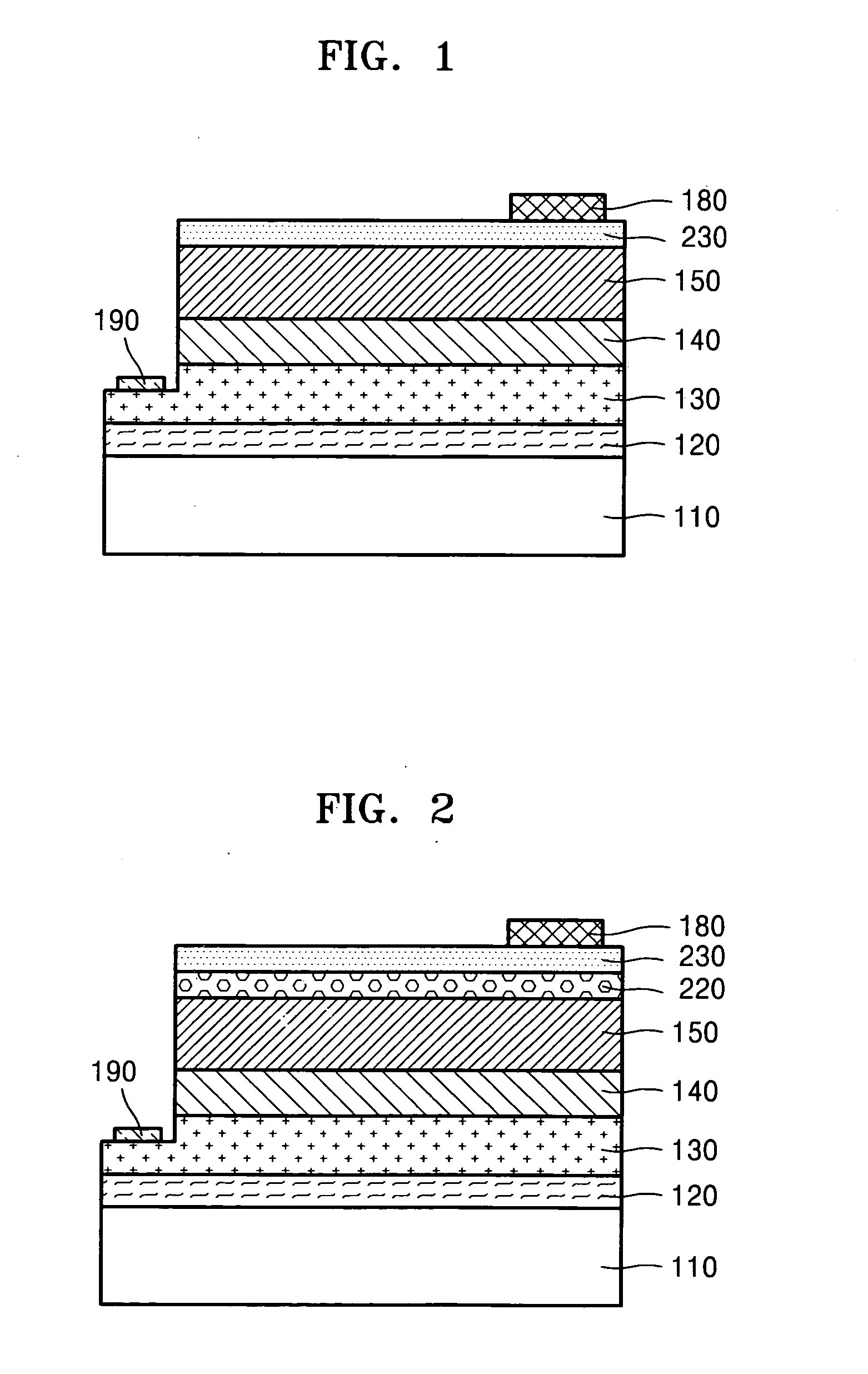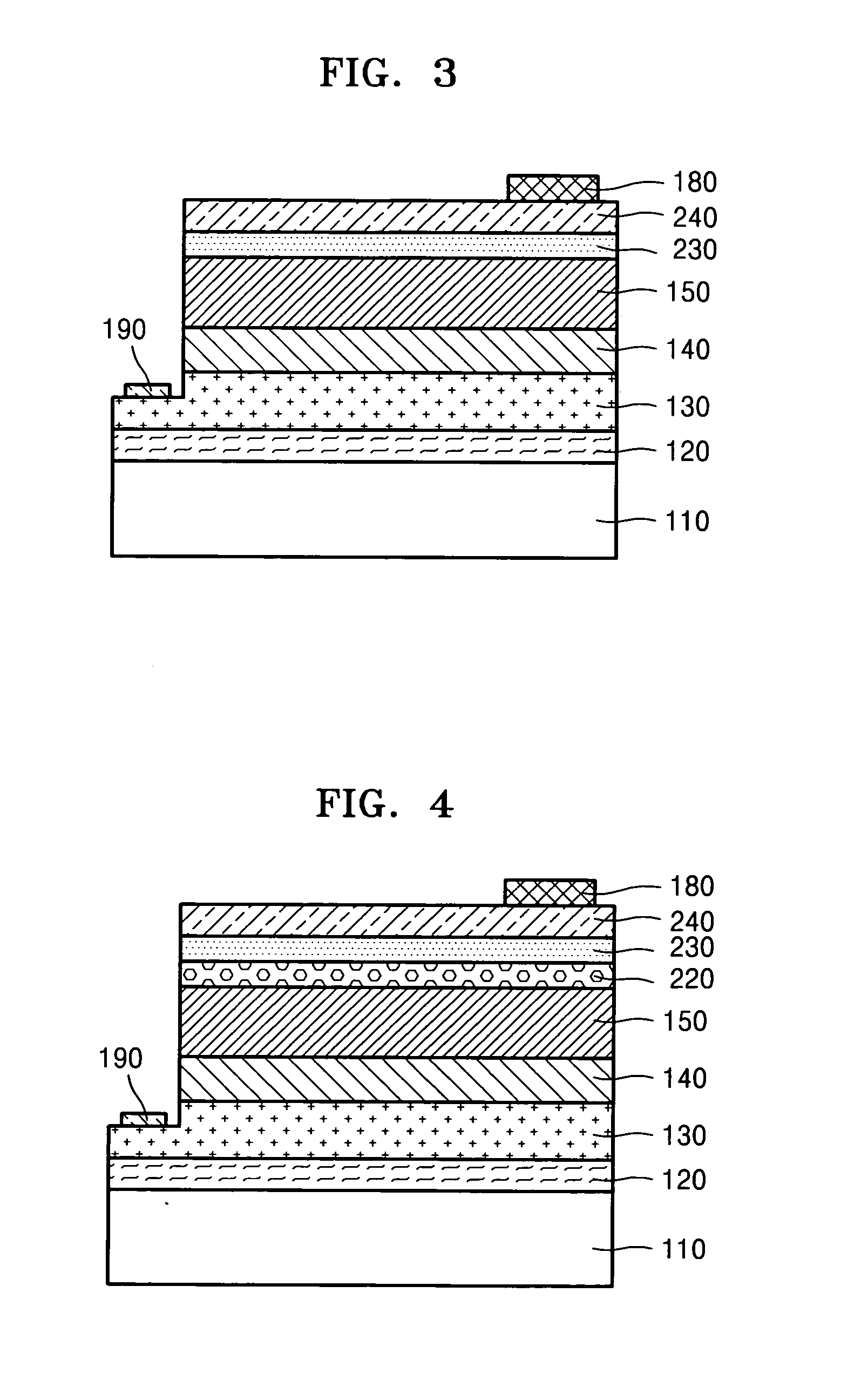Nitride-based light emitting device and method of manufacturing the same
a light emitting device and nitride technology, applied in semiconductor lasers, semiconductor/solid-state device details, lasers, etc., can solve the problems of low light utilization efficiency, and the limitation of realizing the next-generation light emitting device with large capacity and high brightness. , to achieve the effect of high light transmittance and low specific contact resistivity
- Summary
- Abstract
- Description
- Claims
- Application Information
AI Technical Summary
Benefits of technology
Problems solved by technology
Method used
Image
Examples
first embodiment
[0032] Referring to FIG. 1, a light emitting device with a p-electrode structure according to the present invention includes a substrate 110, and a buffer layer 120, an n-cladding layer 130, an active layer 140, a p-cladding layer 150 and an ohmic contact layer 230 sequentially formed on the substrate 110. The light emitting device further includes a p-electrode pad 180 and an n-electrode pad 190.
[0033] The substrate 110 may be formed from one of sapphire, silicon carbide (SiC), Si, and GaAs. The buffer layer 120 may not be formed. Each of the layers from the buffer layer 120 up to the p-cladding layer 150 is basically made from a compound selected among III-nitride-based compounds represented by the general formula AlxInyGazN (0≦x≦1, 0≦y≦1, 0≦z≦1, 0≦x+y+z≦1), and the n- and p-cladding layers 130 and 150 contain appropriate dopants in addition to the compounds. The active layer 140 may be formed as a single layer or a multiquantum well (MQW) layer or in other various ways known in t...
second embodiment
[0048]FIG. 2 is a cross-sectional view of a light emitting device with a p-electrode structure according to the present invention. Referring to FIG. 2, the light emitting device includes an insertion layer 220 between an ohmic contact layer 230 and a p-cladding layer 150. That is, the p-electrode structure includes the insertion layer 220 and the ohmic contact layer 230. The insertion layer 220 can be made of a material that helps to form another transparent conductive oxide during annealing after deposition as well as gallide that is a gallium-based compound in order to increase effective carrier (hole) concentration on the surface of the p-cladding layer 150.
[0049] To satisfy the requirements, the insertion layer 220 is made of at least one selected from the group consisting of Ni, NixOy, Au, Pt, Pd, Mg, Cu, CuxOy, Zn, Ag, Sc, Co, CoxOy, Rh, Li, Be, Ca, Ru, Re, Ti, Ta, Na, and La.
[0050] Since the insertion layer 220 helps not only to adjust the carrier concentration in the ohmic ...
third embodiment
[0051]FIG. 3 is a cross-sectional view of a light emitting device with a p-electrode structure according to the present invention. Referring to FIG. 3, the light emitting device includes a reflective layer 240 overlying an ohmic contact layer 230. That is, the p-electrode structure includes the ohmic contact layer 230 and the reflective layer 240. The reflective layer 240 is used for realization of a flip-chip light emitting device and may contain at least one metal selected from the group consisting of Ag, Al, Zn, Mg, Ru, Ti, Rh, Cr, and Pt. The reflective layer 240 may be formed to a thickness of 100 to 2,000 nm.
[0052]FIG. 4 shows an example of a light emitting device including the reflective layer 240 in addition to the light emitting device structure of FIG. 2.
PUM
 Login to View More
Login to View More Abstract
Description
Claims
Application Information
 Login to View More
Login to View More - R&D
- Intellectual Property
- Life Sciences
- Materials
- Tech Scout
- Unparalleled Data Quality
- Higher Quality Content
- 60% Fewer Hallucinations
Browse by: Latest US Patents, China's latest patents, Technical Efficacy Thesaurus, Application Domain, Technology Topic, Popular Technical Reports.
© 2025 PatSnap. All rights reserved.Legal|Privacy policy|Modern Slavery Act Transparency Statement|Sitemap|About US| Contact US: help@patsnap.com



